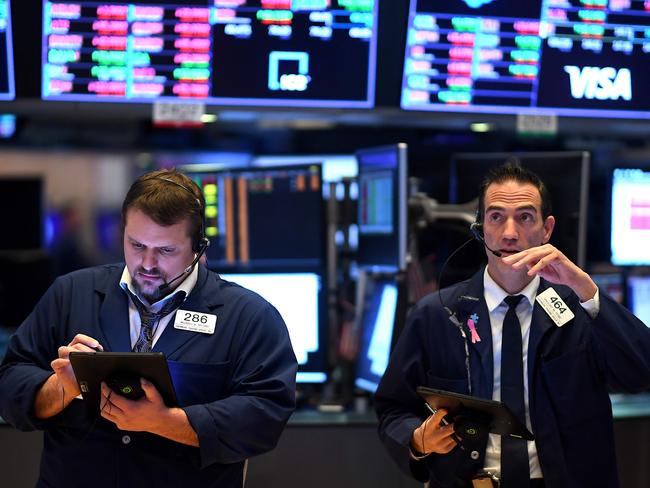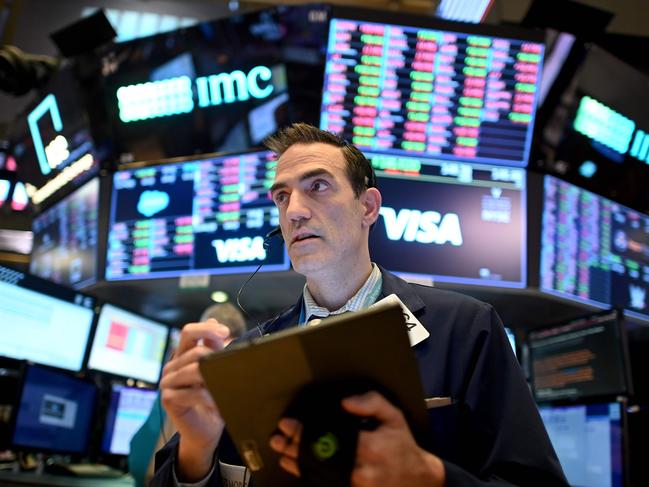Australian share market has its worst week in 12 years
The Australian share market has had its worst week since 2008, with benchmark S&P/ASX200 finishing up 0.7 per cent.
Markets
Don't miss out on the headlines from Markets. Followed categories will be added to My News.
It has been the worst week for the Australian share market since October 2008, with a modest gain.
The benchmark S&P/ASX200 finished Friday up 33.7 points, or 0.7 per cent, at 4,816.6.
The broader All Ordinaries index gained 44.9 points, or 0.93 per cent, to 4,854.3.
The Australian dollar is now worth 58.54 US cents.
While it does seem low, it is up from 56.89 US cents when the ASX closed on Thursday.
The update follows the Australian stock market rebounding 3.5 per cent after a much-needed surge on US and European markets.

Confidence rose as investors saw governments and central banks taking action to ease the economic pain of the coronavirus outbreak, analysts say.
The benchmark S & P/ASX200 surged 171.3 points, or 3.58 per cent, to 4,954.2 as at 10.15am AEDT on Friday, with all indices in the green except health care.
The broader All Ordinaries index jumped 172.4 points, or 3.58 per cent, to 4,981.8.
David de Garis, of NAB’s morning call podcast, said some of the optimism was coming from the recent flood of coronavirus management policy announcements and as central banks ease liquidity concerns.
MORE NEWS
Royal tests positive for coronavirus
Queen makes London escape amid virus fears
Race is on for vaccine as Palmer splashes $1m on research
Doctor reveals eerie life on the coronavirus frontline
The local bourse shrugged off an RBA rate cut on Thursday to close in negative territory.
The ASX200 has lost 33.5 per cent in the past four weeks.
The Australian dollar plunged to a low of 55.08 US cents at one point on Thursday, a level last seen in October 2002.
One Aussie dollar was buying 56.81 US cents at 10.15am AEDT on Friday, down from 56.89 US cents at Thursday’s ASX close.
It came as US oil prices surged 35 per cent overnight after a three-day sell off and the global benchmark Brent also lifted as financial markets assessed the impact of massive central bank stimulus measures.
The local bourse shrugged off an RBA rate cut yesterday to close in negative territory.
WALL STREET CLIMBS
Stocks capped a wobbly day on Wall Street with solid gains Thursday (local time), reflecting cautious optimism among investors that emergency action by the US government and central banks will cushion the global economy from a looming recession caused by the coronavirus pandemic.
The swings in the market were markedly less volatile than recent days. The Dow Jones Industrial Average gained almost 200 points, or 0.9 per cent.
The S & P 500 rose 0.5 per cent after bouncing between a gain of 2.9 per cent and a loss of 3.3 per cent early.
That would be a notable change in normal times, but the index has had eight straight days where it bounced up or down between 4.9 per cent and 12 per cent.
Markets have been so volatile because investors are weighing the increasing likelihood of a recession on one hand against huge, emergency efforts to prop up the economy on the other. Markets got more of each on Thursday (local time).

The number of Americans filing for unemployment benefits jumped by 70,000 last week, more than economists expected, in one of the first signs of lay-offs sweeping across the country.
Wide swaths of the economy are grinding closer to a standstill, from the travel industry to restaurants, as authorities ask Americans to stay home to slow the spread of the virus. Another weak manufacturing report, this time in the mid-Atlantic region, added to the worries.
But the world’s largest central banks announced their latest efforts to support financial markets and the economy.
The European Central Bank launched an expanded program to buy up to 750 billion euros ($A1.4 trillion) in bonds, and the Bank of England cut its key interest rate to a record low of 0.1 per cent.

The Federal Reserve unveiled measures to support money-market funds and the borrowing of dollars as investors in markets worldwide hurry to build up dollars and cash. The dash for cash has strained markets, and sellers of even high- quality bonds say they’re having difficulty finding buyers at reasonable prices.
Many of the Fed’s moves, which are getting revived after being used in the 2008 financial crisis, are aimed at smoothing out operations in such markets.
“Every day there’s another announcement of what the stimulus is going to look like, but what seems to be apparent is the recognition of some in the administration that funding is going to have to be larger, more significant than initially expected,” said Quincy Krosby, chief market strategist at Prudential Financial.
Investors also appeared encouraged by reports that China is set to ramp up stimulus spending after the province where the virus first emerged showed no new infections on Wednesday.
Originally published as Australian share market has its worst week in 12 years
